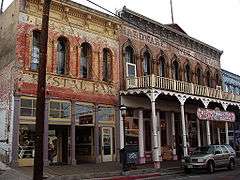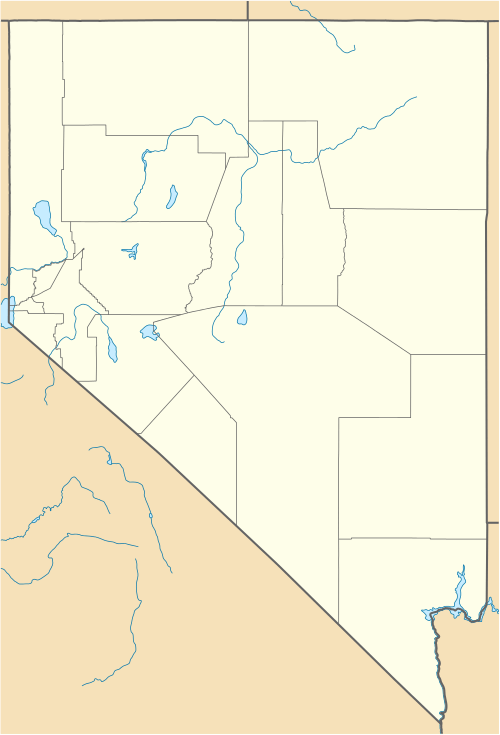Virginia City Historic District (Virginia City, Nevada)
Coordinates: 39°18′37″N 119°38′58″W / 39.31028°N 119.64944°W
|
Virginia City Historic District | |
 | |
  | |
| Location | Virginia City, Nevada, USA |
|---|---|
| Built | 1859 |
| Architect | Unknown |
| Architectural style | Bungalow/craftsman, Late Victorian |
| NRHP Reference # | 66000458 |
| Significant dates | |
| Added to NRHP | October 15, 1966[1] |
| Designated NHLD | July 4, 1961[2] |

Virginia City Historic District is a National Historic Landmark encompassing the former mining villages of Virginia City and Gold Hill, both in Storey County, as well as Dayton and Silver City, both to the south in adjacent Lyon County, Nevada, United States. Declared a National Historic Landmark in 1961, it is one of only six in the state of Nevada.[2][4]
Virginia City was the prototype for future frontier mining boom towns, with its industrialization and urbanization.[5] It owed its success to the 1859 discovery of the Comstock Lode. It is laid out in a grid pattern 1,500 feet below the top of Mount Davidson. Most of the buildings are two to three story brick buildings, with the first floors used for saloons and shops. It was the first silver rush town, and the first to intensely apply large-industrial mining methods.[5][6]
After a year in existence, the boomtown had 42 saloons, 42 stores, 6 restaurants, 3 hotels, and 868 dwellings to house a town residency of 2,345. At its height in 1863, the town had 15,000 residents. From its creation in 1859 to 1875, there were five widespread fires. The 1875 fire, dubbed the Great Fire of 1875, caused $12,000,000 in damages.[7]
Today, Virginia City is but a shadow of its former glory; however, it still draws over 2 million visitors per year. In 2004, its condition was considered "threatened". One reason is that an inactive mining pit may cause some of the buildings that make up the historic nature of the district to slide into the pit. The cemeteries are constantly vandalized and are in danger of erosion. Continued use of the district for tourism is harming those historical buildings still in use, and neglect of privately held unused buildings increases the damage to the district.[2]
Other NRHP listings within the district
- Piper's Opera House, 1885
- Henry Piper House, 1875
Contributing properties
Contributing properties in the historic district include:
- First Presbyterian Church - built in 1867, it is one of the few buildings built before the Great Fire that still stands today;
- Fourth Ward School - now a museum, it was a school from its construction in 1876 to 1936;
- Knights of Pythias Building, West side B Street, between Union & Sutton Streets, this cast iron and stuccoed brick building was built in 1875;
- St. Mary's in the Mountains Catholic Church, St. Mary's is a basilican structure and still has services;
- St. Paul's Episcopal Church - Built in 1876 and still used for services;
- Storey County Courthouse - Built after the 1875 fire, the rectangular brick building is still in use;
- Territorial Enterprise building - built in 1862, Mark Twain once worked in the building.[8]
- C.J. Prescott House, at 12 Hickey St., built in 1864.[9]
References
- ↑ National Park Service (2007-01-23). "National Register Information System". National Register of Historic Places. National Park Service.
- 1 2 3 "Virginia City Historic District". National Historic Landmark summary listing. National Park Service. Retrieved 2008-01-23.
- ↑ Savage Mining Company Office
- ↑ Charles Snell and Marilynn Larew (April 21, 1978), National Register of Historic Places Inventory-Nomination: Virginia City Historic District (pdf), National Park Service and Accompanying 50 or so photos from 1968, 1971, 1978 and other dates. (8.81 MB)
- 1 2 Virginia Historic District -Three Historic Nevada Cities: Carson City, Reno and Virginia City-A National Register of Historic Places Travel Itinerary
- ↑ Snell and Larew, pg.2, 5, 7
- ↑ Snell and Larew, pg.2, 8, 9
- ↑ Snell and Larew, pgs 2-4
- ↑ Bernadette Franke and Andria S. Daley (April 1993). "National Register of Historic Places Inventory/Nomination: C.J. Prescott House" (PDF). National Park Service. and accompanying photo from 1993
External links
| Wikimedia Commons has media related to Virginia City, Nevada. |
- National Park Service: Virginia City Historic District website
- Historical Marker Data Base — list of all available markers in Virginia City
Located in Virginia City, Storey County, Nevada:
- HABS No. NV-15-1, "C Street Area Survey (Commercial Buildings)", 21 photos
- HABS No. NV-15-2, "Brick Vaults, Office of Consolidated Virginia Mining Company", 1 photo
- HABS No. NV-15-3, "Virginia Hotel, C Street", 1 photo
- HABS No. NV-15-4, "Virginia City Union Sunday School, C Street", 1 photo
- HABS No. NV-15-5, "Blaubelt Mansion", 2 photos
- HABS No. NV-15-7, "Piper's Opera House, B & Union Streets", 8 photos, 7 measured drawings
- HABS No. NV-15-8, "Hardware & General Store, C Street", 1 photo
- HABS No. NV-15-9, "Mark Twain "Enterprise" Building, C Street", 1 photo
- HABS No. NV-15-11, "Knights of Pythias Hall, West side B Street, between Union & Sutton Streets", 1 photo, 5 measured drawings
- HABS No. NV-15-12, "Savage Mining Office", 2 photos
- HABS No. NV-15-18, "Masonic Hall, C Street", 1 photo
- HABS No. NV-15-19, "Storey County Courthouse", 5 photos
- HABS No. NV-15-20, "Miners' Union Hall, West side B Street, between Union & Sutton Streets", 2 photos, 5 measured drawings
- HABS No. NV-15-21, "Fourth Ward School, South C Street at Highway 17", 3 photos, 9 measured drawings
- HABS No. NV-15-26, "Frederick House, D Street", 2 photos
- HABS No. NV-15-29, "Crystal Saloon", 4 photos
- HABS No. NV-15-30, "Episcopal Church, D Street", 2 photos
- HABS No. NV-15-31, "King House", 8 photos
- HABS No. NV-15-32, "Virginia City News Building, C Street", 1 photo
- HABS No. NV-15-33, "Old Bar, C Street", 1 photo
- HABS No. NV-15-35, "Comstock House, C Street", 1 photo
- HABS No. NV-15-36, "Palace Clothing Store Building, C Street", 1 photo
- HABS No. NV-15-37, "Union Brewery", 1 photo
- HABS No. NV-15-38, "Molinelli's Hotel, C Street", 1 photo
- HABS No. NV-15-39, ""Evening Chronicle" Building, C Street", 1 photo
- HABS No. NV-15-40, "Silver Hotel, C Street", 1 photo
- HABS No. NV-15-41, "Norcross Mining Office", 3 photos
- HABS No. NV-15-46, "Wells Fargo Building, C Street", 9 photos
- HABS No. NV-15-52, "St. Mary's in the Mountains", 11 photos
- HABS No. NV-15-54, "Jail", 3 photos
- HABS No. NV-15-58, "Frame House", 4 photos
- HABS No. NV-15-77, "Virginia City, General View Area Survey", 11 photos
- HABS No. NV-15-78, "First Street (Commercial Buildings)", 1 photo
- HABS No. NV-15-79, "Cemetery", 6 photos
- HABS No. NV-15-80, "Frame Store", 1 photo
- HABS No. NV-15-81, "Harness Shop", 1 photo
- HABS No. NV-15-82, "Hose House", 1 photo
- HABS No. NV-15-83, "Sutro Mansion", 1 photo
- HABS No. NV-15-84, "Shaft House, Active Mine", 1 photo
- HABS No. NV-15-85, "Shaft House, Consolidated California & Virginia Mine", 1 photo
- HABS No. NV-15-86, "Mine, General View", 1 photo
- HABS No. NV-15-87, "Fire House", 1 photo
- HABS No. NV-15-88, "Fire Station", 2 photos
- HABS No. NV-15-89, "Hall of Records, B Street", 2 photos
Located in other villages in the district:
- HABS No. NV-15-13, "Liberty Fire House, Gold Hill, Storey County, NV", 2 photos
- HABS No. NV-15-14, "Miner's Union Hall, B Street, Gold Hill, Storey County, NV", 4 photos
- HABS No. NV-10-1, "Sutro Tunnel Entrance, Comstock Mines vicinity, Dayton vicinity, Lyon County, NV", 1 photo
- HABS No. NV-13-30, "Bluestone Manufacturing Company, Main Street & Shady Avenue, Dayton, Lyon County, NV", 1 measured drawing
- HAER No. NV-3, "Donovan's Mill, Silver City, Lyon County, NV", 46 photos, 7 data pages, 4 photo caption pages